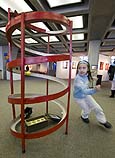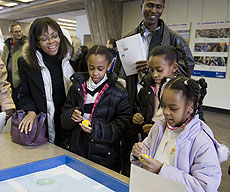Open house opens
minds to science
 |
| A girl participates in a hands-on acceleration experiment at the Fermilab Family Open House on Saturday, Jan. 17. |
About 3,500 guests, many of them children, accepted Fermilab's invitation to bring their questions and curiosity to Fermilab's Family Open House on Saturday.
"This is primarily for kids," said Spencer Pasero, an education program leader at Fermilab. "We want to let them have some fun and learn some science."
Docents and volunteers with Fermilab's Education Office led children in hands-on experiments and crafts in Wilson Hall. Guests also watched demonstrations about the physics of static electricity or spinning tops or the amusing properties of liquid nitrogen.
"We try to tie everything we're doing into the lab," Pasero said. At the Open House, he demonstrated how a particle accelerator works by using magnets to accelerate steel ball bearings around a ring to smash a walnut.
Physicists stationed on the 15th floor of Wilson Hall took on the most complicated questions parents and kids brought to the Open House.
Fermilab scientist Herman White said some parents asked about the benefits of particle physics research. But the most common question from both kids and adults was: "What do you do here?"
In giving kid-friendly answers, you have to take a chance sometimes, and explain something that might seem too complicated for a child to comprehend, White said. "They may not understand everything, but you can engage their enthusiasm."
Perhaps the seeds planted on Saturday will blossom into an interest in the pursuit of scientific knowledge for children like 6-year-old Sophia Ciatti.
Sophia isn't sure what she wants to be when she grows up, but she said has liked science since she was a baby.
Sophia's dad, Stephen, a mechanical engineer at Argonne National Laboratory, said he appreciated the opportunity to encourage Sophia's interest.
"She's very bright," he said. "These are the sorts of things I want to make sure she sees."
-- Kathryn Grim

A family at the Fermilab Family Open House on Saturday, Jan. 17, digs into balls of clay with paperclips. The activity demonstrated that you do not need to see what you are looking for to identify it.
|